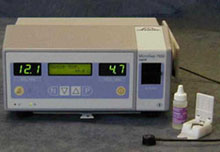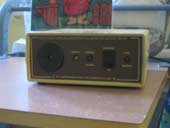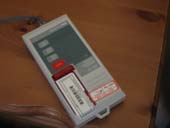|
Monitoring
Alot of the wires surrounding babies are for monitoring purposes.

In the Intensive Care area we use the Kontron monitors shown above. The top line is baby's heart rate which we try to keep between around 110 - 180 per minute. The next line is baby's oxygen saturation levels. This is shown as a percentage and tells us how much oxygen is getting into the baby's bloodstream. We try to keep these 'sats' above around 86%, but babies very often fluctuate and nurses may need to increase or decrease the amount of oxygen given (too much oxygen can affect baby's eyesight). The yellow line is the number of times that the baby breathes every minute, however this can be fairly inaccurate, so you will sometimes see nurses counting the baby's respirations per minute ('resps') themselves. The white numbers on the bottom are the baby's temperatures, measured on the torso, and the foot. We aim to keep baby's 'core' temperature between around 36.5 -
37.5°C.

Another monitor commonly used is the transcutaneous monitor (right), which measures levels of oxygen and carbon dioxide through the skin.
You may also see baby's blood pressure monitored via a line placed in an artery.

Babies who are not on any of the above types of monitoring will always have an apnoea alarm ('apnoea' is a medical term meaning to stop breathing).
 Apnoea monitors are either a pad that sits underneath the baby (attached to the machine shown above) or a small round piece of sponge stuck to the baby's abdomen (attached to the machine shown right). These machines will alarm if the baby pauses for too long between two breaths. Apnoea monitors are either a pad that sits underneath the baby (attached to the machine shown above) or a small round piece of sponge stuck to the baby's abdomen (attached to the machine shown right). These machines will alarm if the baby pauses for too long between two breaths.
Alarms
Each type of monitor and piece of equipment has an alarm to warn staff of problems or remind them to do something. Alarms are constantly going off around an intensive care unit, and it may take parents a while to recognise the difference between 'routine' alarm noises and ones that mean that their baby needs more immediate help.
|



